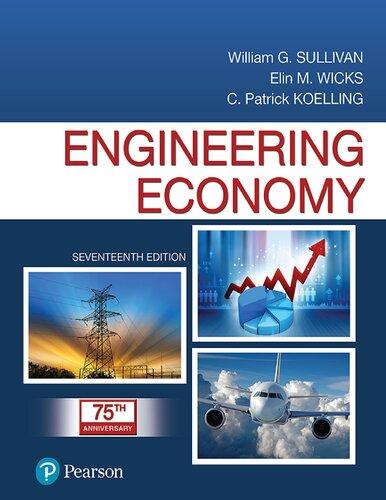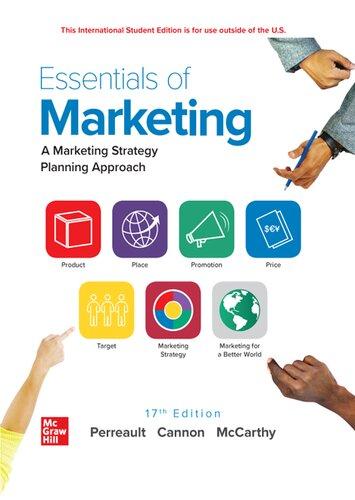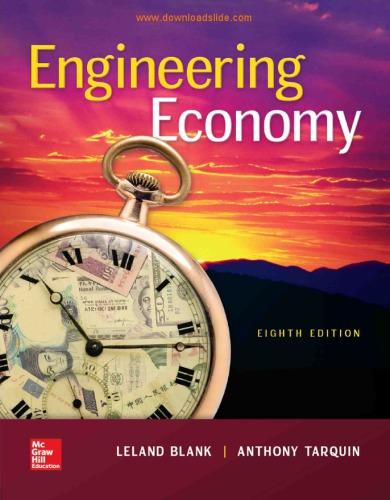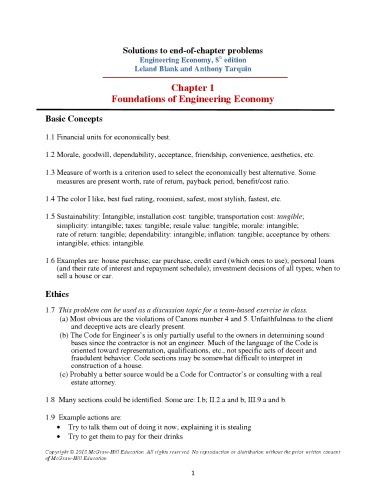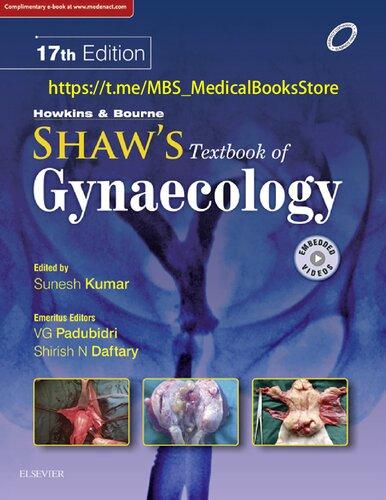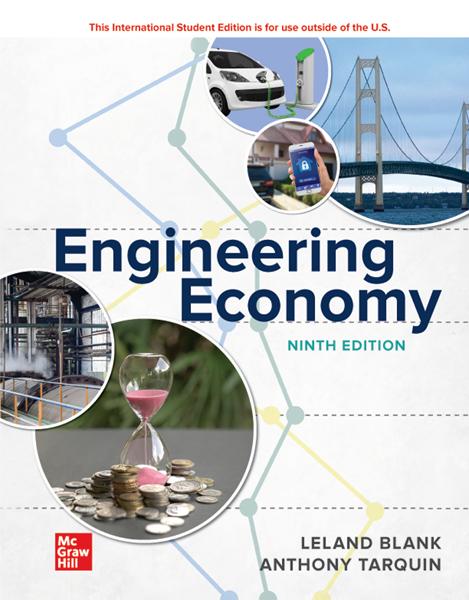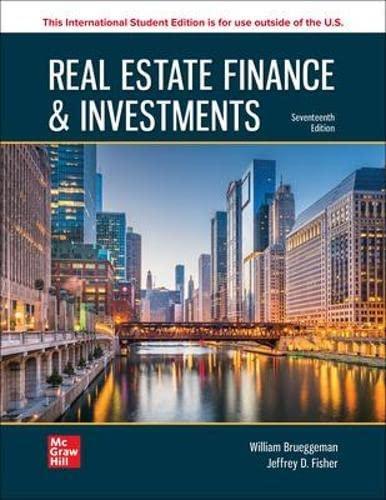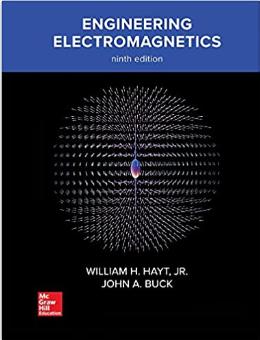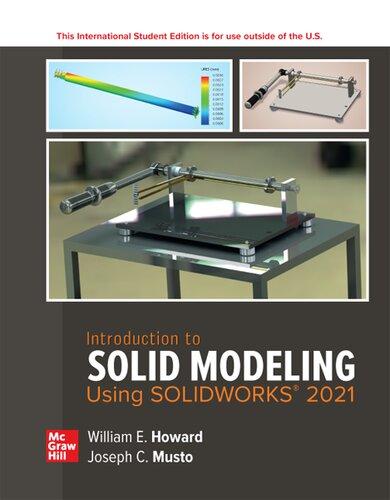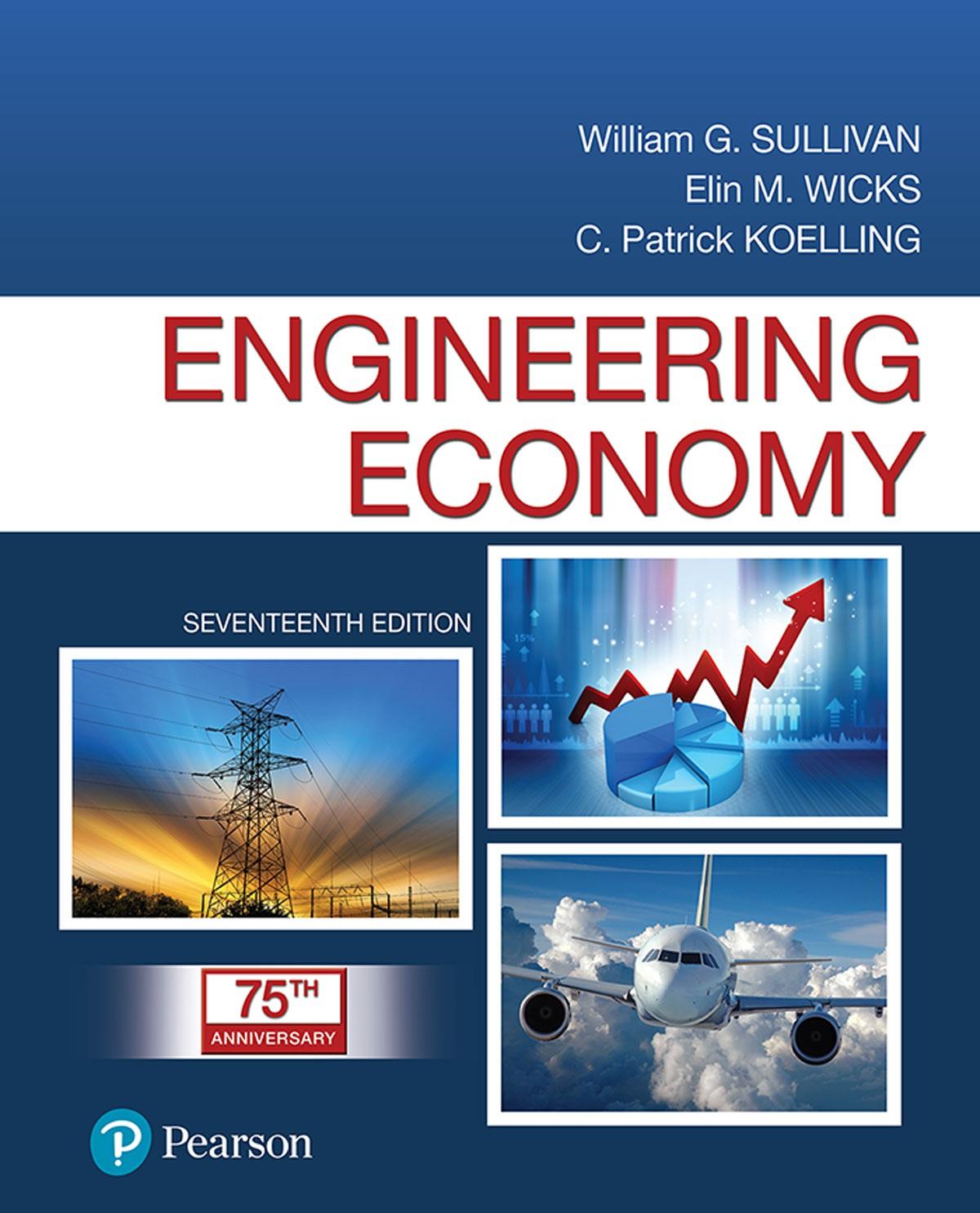Engineering Economy 17th Edition
William G. Sullivan
Visit to download the full and correct content document: https://ebookmass.com/product/engineering-economy-17th-edition-william-g-sullivan/
More products digital (pdf, epub, mobi) instant download maybe you interests ...
ISE Essentials of Marketing 17th Edition William Perreault
https://ebookmass.com/product/ise-essentials-of-marketing-17thedition-william-perreault/
Engineering Economy 8th Edition Leland Blank
https://ebookmass.com/product/engineering-economy-8th-editionleland-blank/
Engineering Economy Solution Manual 8th Edition Leland Blank
https://ebookmass.com/product/engineering-economy-solutionmanual-8th-edition-leland-blank/
Understanding Business, 13th Edition William G. Nickels
https://ebookmass.com/product/understanding-business-13thedition-william-g-nickels/
Shaw's Textbook of Gynaecology 17th Revised edition
Edition V. G. Padubidri
https://ebookmass.com/product/shaws-textbook-of-gynaecology-17threvised-edition-edition-v-g-padubidri/
Engineering Economy, 9th Edition Leland T. Blank
https://ebookmass.com/product/engineering-economy-9th-editionleland-t-blank/
Real Estate Finance & Investments 17th Edition Jeffrey Fisher William B. Brueggeman
https://ebookmass.com/product/real-estate-financeinvestments-17th-edition-jeffrey-fisher-william-b-brueggeman/
Engineering Electromagnetics 9th Edition William H. Hayt
https://ebookmass.com/product/engineering-electromagnetics-9thedition-william-h-hayt/
Introduction to Solid Modeling Using SOLIDWORKS 2021 17th Edition William E. Howard
https://ebookmass.com/product/introduction-to-solid-modelingusing-solidworks-2021-17th-edition-william-e-howard/
3.8TryYourSkills93 3.9Summary96
CHAPTER4 TheTimeValueofMoney104
4.1Introduction105
4.2SimpleInterest106
4.3CompoundInterest107
4.4TheConceptofEquivalence107
4.5NotationandCash-FlowDiagramsandTables110
4.6RelatingPresentandFutureEquivalentValuesofSingleCash Flows114
4.7RelatingaUniformSeries(Annuity)toItsPresentandFuture EquivalentValues120
4.8SummaryofInterestFormulasandRelationshipsforDiscrete Compounding130
4.9DeferredAnnuities(UniformSeries)131
4.10EquivalenceCalculationsInvolvingMultipleInterest Formulas133
4.11Uniform(Arithmetic)GradientofCashFlows139
4.12GeometricSequencesofCashFlows144
4.13InterestRatesthatVarywithTime149
4.14NominalandEffectiveInterestRates151
4.15CompoundingMoreOftenthanOnceperYear153
4.16InterestFormulasforContinuousCompoundingandDiscrete CashFlows156
4.17CaseStudy—UnderstandingEconomic“Equivalence”159 4.18In-ClassExercise162
4.19TryYourSkills162 4.20Summary171
CHAPTER5 EvaluatingaSingleProject188
5.1Introduction189
5.2DeterminingtheMinimumAttractiveRateofReturn (MARR)190
5.3ThePresentWorthMethod191
5.4TheFutureWorthMethod198
5.5TheAnnualWorthMethod199
5.6TheInternalRateofReturnMethod204
5.7TheExternalRateofReturnMethod215
5.8ThePayback(Payout)PeriodMethod217
5.9CaseStudy—AProposedCapitalInvestmenttoImprove ProcessYield220
CHAPTER8
PriceChangesandExchangeRates385
8.1Introduction386
8.2TerminologyandBasicConcepts387
8.3FixedandResponsiveAnnuities393
8.4DifferentialPriceChanges398
8.5SpreadsheetApplication400
8.6ForeignExchangeRatesandPurchasingPowerConcepts402
8.7CaseStudy—SelectingElectricMotorstoPoweranAssembly Line407
8.8In-ClassExercise410
8.9TryYourSkills410
8.10Summary412
CHAPTER9 ReplacementAnalysis422
9.1Introduction423
9.2ReasonsforReplacementAnalysis423
9.3FactorsthatMustBeConsideredinReplacementStudies424
9.4TypicalReplacementProblems427
9.5DeterminingtheEconomicLifeofaNewAsset(Challenger)430
9.6DeterminingtheEconomicLifeofaDefender434
9.7ComparisonsinWhichtheDefender’sUsefulLifeDiffersfrom thatoftheChallenger437
9.8RetirementwithoutReplacement(Abandonment)440
9.9After-TaxReplacementStudies441
9.10CaseStudy—ReplacementofaHospital’sEmergencyElectrical SupplySystem449
9.11In-ClassExercise453
9.12TryYourSkills453 9.13Summary454
CHAPTER10 EvaluatingProjectswiththeBenefit CostRatioMethod463
10.1Introduction464
10.2PerspectiveandTerminologyforAnalyzingPublic Projects465
10.3Self-LiquidatingProjects466
10.4Multiple-PurposeProjects466
10.5DifficultiesinEvaluatingPublic-SectorProjects469
10.6WhatInterestRateShouldBeUsedforPublicProjects?470
10.7TheBenefit CostRatioMethod472
10.8EvaluatingIndependentProjectsbyB
CHAPTER11
CHAPTER12
12.4EvaluationofProjectswithDiscreteRandomVariables529
12.5EvaluationofProjectswithContinuousRandomVariables538
12.6EvaluationofRiskandUncertaintybyMonteCarloSimulation543
12.7PerformingMonteCarloSimulationwithaComputer547
CHAPTER13
DecisionMakingConsideringMultiattributes596
14.1Introduction597
14.2ExamplesofMultiattributeDecisions597
14.3ChoiceofAttributes599
14.4SelectionofaMeasurementScale599
14.5DimensionalityoftheProblem600
14.6NoncompensatoryModels600
14.7CompensatoryModels605
14.8Summary613
AppendixAAccountingFundamentals619 AppendixBAbbreviationsandNotation629 AppendixCInterestandAnnuityTablesforDiscreteCompounding633 AppendixDInterestandAnnuityTablesforContinuousCompounding652 AppendixEStandardNormalDistribution656 AppendixFSelectedReferences659 AppendixGSolutionstoTryYourSkills662 AppendixHAnswerstoSelectedProblems703 Index707
PREFACE
Weliveinaseaofeconomicdecisions.
Proudlyservingengineeringeducatorsandstudentsforover75years
AboutEngineeringEconomy
Asuccinctjobdescriptionforanengineerconsistsoftwowords: problemsolver. Broadlyspeaking,engineersuseknowledgetofindnewwaysofdoingthings economically.Engineeringdesignsolutionsdonotexistinavacuumbutwithinthe contextofabusinessopportunity.Giventhateveryproblemhasmultiplesolutions,the issueis,Howdoesonerationallyselectthedesignwiththemostfavorableeconomic result?Theanswertothisquestioncanalsobeputforthintwowords: engineering economy.Engineeringeconomyprovidesasystematicframeworkforevaluatingthe economicaspectsofcompetingdesignsolutions.Justasengineersmodelthestresson asupportcolumn,orthethermodynamicresponseofasteamturbine,theymustalso modeltheeconomicimpactoftheirrecommendations.
Engineeringeconomy—whatisit,andwhyisitimportant?Theinitialreaction ofmanyengineeringstudentstothesequestionsis,“Moneymatterswillbehandled bysomeoneelse.TheyarenotsomethingIneedtoworryabout.”Inreality,any engineeringprojectmustbenotonlyphysicallyrealizablebutalsoeconomically affordable.Thisbookisabouthowtomakesmarteconomicchoices.
Understandingandapplyingeconomicprinciplestoengineeringhaveneverbeen moreimportant.Engineeringismorethanaproblem-solvingactivityfocusingon thedevelopmentofproducts,systems,andprocessestosatisfyaneedordemand. Beyondfunctionandperformance,solutionsmustalsobeviableeconomically.Design decisionsaffectlimitedresourcessuchastime,material,labor,capital,andnatural resources,notonlyinitially(duringconceptualdesign)butalsothroughtheremaining phasesofthelifecycle(e.g.,detaileddesign,manufactureanddistribution,service, retirement,anddisposal).Agreatsolutioncandieacertaindeathifitisnotprofitable.
• MyLab EngineeringisavailablewithEngineeringEconomy,17/eandprovidesa powerfulhomeworkandtestmanagerwhichletsinstructorscreate,import,and manageonlinehomeworkassignments,quizzes,andteststhatareautomatically
graded.Youcanchoosefromawiderangeofassignmentoptions,includingtime limits,proctoring,andmaximumnumberofattemptsallowed.Thebottomline: MyLabEngineeringmeanslesstimegradingandmoretimeteaching.
• Automaticallygradedandalgorithmic-generatedhomeworkassignments, quizzes,andteststhatdirectlycorrelatetothetextbook.
• Automaticgradingthattracksstudents’results.
• AssignableAuto-GradedExcelProjectsletstudentsmasterkeyExcelskillswithin theapplicationandreceiveimmediatefeedbackontheirwork.
• Interactive“HelpMeSolveThis”tutorialsprovideopportunityforpoint-of-use helpandmorepractice.
• LearningObjectivesmappedtoABEToutcomesprovidecomprehensive reportingtools.
• VideoSolutionsareavailabletohelpexplainconceptsorwalkstudentsthrough exampleexercisesfromthebook.
What’sNewtoThisEdition?
Ourintentinrevisingthetextistocontinueintegratingcomputertechnologyand realisticexamplestofacilitatelearningengineeringeconomy.Herearethehighlights ofchangesmadeinthepublicationoftheseventeenthedition:
• Approximatelyhalfofallend-of-chapterproblemshavebeenreplacedwithfresh, newproblems.
• The“TryYourSkills”problemsetsattheendofChapters1through8havebeen doubledinproblemcount.“TryYourSkills”problemsetshavealsobeenadded forChapters9through11.
• AppendixA,adescriptionofaccountingfundamentals,hasbeenrewrittenand addedtothebook.
• Groupin-classproblemexerciseshavebeenaddedtothemajorityofchaptersin theseventeenthedition.Theseexercisesareidealforin-class,team-basedproblem solvingwiththreetofourstudentsineachgroup.
• AppendixH,whichfeaturesanswerstoselectedend-of-chapterproblems,has beenaddedtothisnewedition.
• InChapter7weprovideanExceltemplatethatallowsstudentstochangethe effectiveincomerateinproblemsaffectedbyCongressionalupdatestothefederal incometaxlaw(mostlikelyenactedinlate2017).
• Problem-solutionvideoshavebeenupdatedandexpanded.Thesevideosprovide studentswithstep-by-stepsolutionmethodsanddemonstratebothby-handand spreadsheetsolutions.ThesecomplementtheMyLabEngineeringsoftwarethat hasbeenapopularfeatureofpreviouseditions.
StrategiesofThisBook
Thisbookhastwoprimaryobjectives:(1)toprovidestudentswithasound understandingoftheprinciples,basicconcepts,andmethodologyofengineering
economy;and(2)tohelpstudentsdevelopproficiencywiththesemethodsandwith theprocessformakingrationaldecisionstheyarelikelytoencounterinprofessional practice. Interestingly,anengineeringeconomycoursemaybeastudent’sonlycollege exposuretothesystematicevaluationofalternativeinvestmentopportunities.Inthis regard, EngineeringEconomy isintendedtoserveasatextforclassroominstruction and asabasicreferenceforusebypracticingengineersinallspecialtyareas(e.g., chemical,civil,computer,electrical,industrial,andmechanicalengineering).The bookisalsousefultopersonsengagedinthemanagementoftechnicalactivities.
Thisbookiswrittentoappealtoengineeringstudentswithawidevarietyof personalinterestsandmajors.Ourstudentsarelikemostcollegestudents,variedin theireducationalandcareerinterestsandeagerforchallengingworkthatwillinspire them.Theexplanationsandexamplesinthebookarestudent-centeredandeminently practicalinreal-lifesituations.Inaddition,multimediaresourcesareavailableonline inMyLabEngineeringforstudentsandinstructorslookingtosupplementtheprint book’scontents.
Asatextbook,theseventeentheditioniswrittenprincipallyforthefirstformal courseinengineeringeconomy.Athree-credit-hoursemestercourseshouldbeableto coverthemajorityoftopicsinthisedition,andthereissufficientdepthandbreadthto enableaninstructortoarrangecoursecontenttosuitindividualneeds.Representative syllabiforathree-creditandatwo-creditsemestercourseinengineeringeconomyare providedinTableP-1.Moreover,becauseseveraladvancedtopicsareincluded,this bookcanalsobeusedforasecondcourseinengineeringeconomy.
Allchaptersandappendiceshavebeenrevisedandupdatedtoreflectcurrent trendsandissues.Also,numerousexercisesthatinvolveopen-endedproblem statementsanditerativeproblem-solvingskillsareincludedthroughoutthebook. Alargenumberofthe750-plusend-of-chapterexercisesarenew,andmanysolved examplesrepresentingrealisticproblemsthatariseinvariousengineeringdisciplines arepresented.
Inthe21stcentury,Americaisturningoveranewleafforenvironmental sustainability.Wehaveworkedhardtocapturethisspiritinmanyofourexamples andend-of-chapterproblems.Infact,morethan160“green”problemsandexamples havebeenintegratedthroughoutthisedition.TheyarelistedintheGreenContent sectionfollowingthePreface.
FundamentalsofEngineering(FE)exam–stylequestionsareincludedtohelp prepareengineeringstudentsforthismilestoneexamination,leadingtoprofessional registration.PassingtheFEexamisafirststepingettinglicensedasaprofessional engineer(PE).EngineeringstudentsshouldseriouslyconsiderbecomingaPEbecause itopensmanyemploymentopportunitiesandincreaseslifetimeearningpotential.
Itisgenerallyadvisabletoteachengineeringeconomyattheupperdivision level.Here,anengineeringeconomycourseincorporatestheaccumulatedknowledge studentshaveacquiredinotherareasofthecurriculumandalsodealswithiterative problemsolving,open-endedexercises,creativityinformulatingandevaluating feasiblesolutionstoproblems,andconsiderationofrealisticconstraints(economic, aesthetic,safety,etc.)inproblemsolving.
Alsoavailabletoadoptersofthiseditionisaninstructor’sSolutionsManualand otherclassroomresources.Inaddition,PowerPointvisualaidsarereadilyavailableto instructors.Visit www.pearson.com formoreinformation.
TABLEP-1 TypicalSyllabiforCoursesinEngineeringEconomy
SemesterCourse(TwoCreditHours)
Topic(s)
No.ofClass
Chapter(s) Periods
SemesterCourse(ThreeCreditHours)
Topic(s)
Weekofthe
Chapter Semester
11IntroductiontoEngineeringEconomy11IntroductiontoEngineeringEconomy 22CostConceptsandDesign24CostConcepts,SingleVariable EconomicsTrade-OffAnalysis,and 33Cost-EstimationTechniquesPresentEconomy 44–5TheTimeValueofMoney45TheTimeValueofMoney
Test#1
56EvaluatingaSingleProject1,2,41
67ComparisonandSelection33DevelopingCashFlowsand amongAlternativesCost-EstimationTechniques 8 MidtermExamination
52EvaluatingaSingleProject
79DepreciationandIncomeTaxes64ComparisonandSelection 1010EvaluatingProjectswiththeamongAlternatives
Test#2
Benefit–CostRatioMethod3,5,61
811PriceChangesandExchangeRates112BreakevenandSensitivityAnalysis 1112BreakevenandSensitivityAnalysis75DepreciationandIncomeTaxes 913ReplacementAnalysis141DecisionMakingConsidering 1214ProbabilisticRiskAnalysisMultiattributes 13–1415TheCapitalBudgetingProcess,Alltheabove1 FinalExamination DecisionMaking ConsideringMultiattributes 15 FinalExamination
Numberofclassperiods:45Numberofclassperiods:30
EngineeringEconomyPortfolio
Inmanyengineeringeconomycourses,studentsarerequiredtodesign,develop, andmaintainanengineeringeconomyportfolio.Thepurposeoftheportfolio istodemonstrateandintegrateknowledgeofengineeringeconomybeyondthe requiredassignmentsandtests.Thisisusuallyanindividualassignment.Professional presentation,clarity,brevity,andcreativityareimportantcriteriatobeusedto evaluateportfolios.Studentsareaskedtokeeptheaudience(i.e.,thegrader)inmind whenconstructingtheirportfolios.
Theportfolioshouldcontainavarietyofcontent.Togetcreditforcontent, studentsmustdisplaytheirknowledge.Simplycollectingarticlesinafolder demonstratesverylittle.Togetcreditforcollectedarticles,studentsshouldreadthem andwriteabriefsummaryofeachone.Thesummarycouldexplainhowthearticle isrelevanttoengineeringeconomy,itcouldcritiquethearticle,oritcouldcheckor extendanyeconomiccalculationsinthearticle.Theportfolioshouldincludeboth thesummaryandthearticleitself.Annotatingthearticlebywritingcommentsinthe marginisalsoagoodidea.Othersuggestionsforportfoliocontentfollow(notethat studentsareencouragedtobecreative):
• Describeandsetuporsolveanengineeringeconomyproblemfromyourown discipline(e.g.,electricalengineeringorbuildingconstruction).
• Chooseaprojectorprobleminsocietyoratyouruniversityandapplyengineering economicanalysistooneormoreproposedsolutions.
• Developproposedhomeworkortestproblemsforengineeringeconomy.Include thecompletesolution.Additionally,statewhichcourseobjective(s)thisproblem demonstrates(includetextsection).
• Reflectuponandwriteaboutyourprogressintheclass.Youmightincludea self-evaluationagainstthecourseobjectives.
• Includeaphotoorgraphicthatillustratessomeaspectsofengineeringeconomy. Includeacaptionthatexplainstherelevanceofthephotoorgraphic.
• Includecompletelyworkedoutpracticeproblems.Useadifferentcolorpento showthesewerecheckedagainsttheprovidedanswers.
• Reworkmissedtestproblems,includinganexplanationofeachmistake.
(Theprecedinglistcouldreflecttherelativevalueofthesuggesteditems;thatis, itemsatthetopofthelistaremoreimportantthanitemsatthebottomofthe list.)
Studentsshoulddevelopanintroductorysectionthatexplainsthepurposeand organizationoftheportfolio.Atableofcontentsandclearlymarkedsectionsor headingsarehighlyrecommended.Citethesource(i.e.,acompletebibliographic entry)ofalloutsidematerial.Remember,portfoliosprovideevidencethatstudents knowmoreaboutengineeringeconomythanwhatisreflectedintheassignmentsand exams.Thefocusshouldbeonqualityofevidence,notquantity.
IconUsedinThisBook
Throughoutthisbook,oneiconwillappearinconnectionwithnumerouschapter openingmaterials,examples,andproblems.
Thisiconidentifiesenvironmental(green)elementsofthebook.Theseelements pertaintoengineeringeconomyproblemsinvolvingenergyconservation,materials substitution,recycling,andothergreensituations.
Assumptions,Precision,andPerspective
Engineeringeconomystudiesnecessitatevariousassumptions(educatedguesses) aboutthefuture.Forexample,wedealwithpredictedcashflowsandinterestrates overextendedfutureperiodsoftime.Mostofthenumericalexamplesinthisbookare generallyroundedtothenearestdollarmainlybecausethereisalackofprecisionin ourestimatesinvolvingfuturecircumstancesfacinganorganization.
InterestfactorstabledinAppendixesCandDhavebeencomputedtofour significantdigitsandmayimplyprecisioninengineeringeconomyproblemsthatis not,infact,realistic.Studentsareremindedthatroundinganswerstoproblemsinthis bookisentirelyappropriate(forinstance,tothenearestdollar,year,oranyothervalue beingsolvedfor).Wealsostronglyrecommendsolvingproblemsfromtheviewpoint oftheprofitseekingownersofanorganization(theshareholdersandbondholders). Consequently,weassumethatmanagerswhoactoneconomicanalysisresultsare rationalpersonsmakingdecisionsobjectivelytotakeadvantageoffeasibleinvestment opportunitiesavailabletothem.
OverviewoftheBook
Thisbookisaboutmakingchoicesamongcompetingengineeringalternatives.Most ofthecash-flowconsequencesofthealternativeslieinthefuture,soourattentionis directedtowardthefutureandnotthepast.InChapter2,weexaminealternatives whenthetimevalueofmoneyisnotacomplicatingfactorintheanalysis.We thenturnourattentioninChapter3tohowfuturecashflowsareestimated.In Chapter4andsubsequentchapters,wedealwithalternativeswherethetimevalue ofmoneyisadecidingfactorinchoosingamongcompetingcapitalinvestment opportunities.
StudentscanappreciateChapters2and3andlaterchapterswhentheyconsider alternativesintheirpersonallives,suchaswhichjobtoacceptupongraduation,which automobileortrucktopurchase,whethertobuyahomeorrentaresidence,andmany otherchoicestheywillface.Tobestudentfriendly,wehaveincludedmanyproblems throughoutthisbookthatdealwithpersonalfinance.Theseproblemsaretimely andrelevanttoastudent’spersonalandprofessionalsuccess,andthesesituations incorporatethestructuredproblem-solvingprocessthatstudentswilllearnfromthis book.
Chapter4concentratesontheconceptsofmoney–timerelationshipsand economicequivalence.Specifically,weconsiderthetimevalueofmoneyinevaluating thefuturerevenuesandcostsassociatedwithalternativeusesofmoney.Then,in
Chapter5,themethodscommonlyusedtoanalyzetheeconomicconsequencesand profitabilityofanalternativearedemonstrated.Thesemethods,andtheirproper useinthecomparisonofalternatives,areprimarysubjectsofChapter6,which alsoincludesadiscussionoftheappropriatetimeperiodforananalysis.Thus, Chapters4,5,and6togetherdevelopanessentialpartofthemethodologyneededfor understandingtheremainderofthebookandforperformingengineeringeconomy studiesonabefore-taxbasis.
InChapter7,theadditionaldetailsrequiredtoaccomplishengineeringeconomy studiesonanafter-taxbasisareexplained.Intheprivatesector,mostengineering economystudiesaredoneonanafter-taxbasis.Therefore,Chapter7addstothebasic methodologydevelopedinChapters4,5,and6.
Theeffectsofinflation(ordeflation),pricechanges,andinternationalexchange ratesarethetopicsofChapter8.Theconceptsforhandlingpricechangesand exchangeratesinanengineeringeconomystudyarediscussedbothcomprehensively andpragmaticallyfromanapplicationviewpoint.
Often,anorganizationmustanalyzewhetherexistingassetsshouldbecontinued inserviceorreplacedwithnewassetstomeetcurrentandfutureoperatingneeds. InChapter9,techniquesforaddressingthisquestionaredevelopedandpresented. Becausethereplacementofassetsrequiressignificantcapital,decisionsmadeinthis areaareimportantanddemandspecialattention.
Chapter10isdedicatedtotheanalysisofpublicprojectswiththebenefit–cost ratiomethodofcomparison.Thedevelopmentofthiswidelyusedmethodof evaluatingalternativeswasmotivatedbytheFloodControlActpassedbythe U.S.Congressin1936.
Concernoveruncertaintyandriskisarealityinengineeringpractice.InChapter 11,theimpactofpotentialvariationbetweentheestimatedeconomicoutcomesof analternativeandtheresultsthatmayoccurisconsidered.Breakevenandsensitivity techniquesforanalyzingtheconsequencesofriskanduncertaintyinfutureestimates ofrevenuesandcostsarediscussedandillustrated.
InChapter12,probabilistictechniquesforanalyzingtheconsequencesofriskand uncertaintyinfuturecash-flowestimatesandotherfactorsareexplained.Discreteand continuousprobabilityconcepts,aswellasMonteCarlosimulationtechniques,are includedinChapter12.
Chapter13isconcernedwiththeproperidentificationandanalysisofallprojects andotherneedsforcapitalwithinanorganization.Accordingly,thecapitalfinancing andcapitalallocationprocesstomeettheseneedsisaddressed.Thisprocessiscrucial tothewelfareofanorganization,becauseitaffectsmostoperatingoutcomes,whether intermsofcurrentproductqualityandserviceeffectivenessorlong-termcapability tocompeteintheworldmarket.Finally,Chapter14discussesmanytime-tested methodsforincludingnonmonetaryattributes(intangibles)inengineeringeconomy studies.
Wewouldliketoextendaheartfelt“thankyou”toourcolleaguesandstudents fortheirmanyhelpfulsuggestions(andcritiques!)forthisseventeenthedition of EngineeringEconomy.Weoweanenormousdebtofgratitudetonumerous individualswhohavecontributedtothisedition:KathrynAbel(StevensInstitute ofTechnology),FarhadAzadivar(UniversityofMassachusettsDartmouth),Patrick A.Brunese(PurdueUniversity),TomCassel(UniversityofPennsylvania),Jeya Chandra(PennsylvaniaStateUniversity),XinChen(SouthernIllinoisUniversity
Edwardsville),HosseinHemati(SanDiegoStateUniversity),BruceJanson (UniversityofColoradoDenver),SolomonLeung(IdahoStateUniversity),and ChristianM.Salmon(WesternNewEnglandUniversity).Also,wetrulyappreciate theinvaluableassistanceoffolksatPearson:HollyStark,ErinAult,andAmanda Brands,whohavemadeinvaluableimprovementstothiseffort.
Chapter1
GREENCONTENT
Pg1Chapter1Opener
Pg14Example1-3
Pg15TryYourSkills1-C
Pg16TryYourSkills1-F
Pg16Problems1-1
Pg17Problems1-3
Pg17Problems1-5
Pg17Problems1-7
Pg17Problems1-9
Pg17Problems1-10
Pg17Problems1-11
Pg17Problems1-12
Pg18Problems1-15
Pg19Problems1-20
Pg19Problems1-21
Chapter2
Pg41Example2-7
Pg43Example2-8
Pg46Example2-11
Pg48Example2-12
Pg51TryYourSkills2-E
Pg51TryYourSkills2-H
Pg52TryYourSkills2-K
Pg53Problems2-3
Pg53Problems2-4
Pg54Problems2-12
Pg55Problems2-16
Pg55Problems2-21
Pg55Problems2-22
Pg55Problems2-23
Pg56Problems2-28
Pg56Problems2-30
Pg57Problems2-31
Pg57Problems2-32
Pg58Problems2-37
Pg59Problems2-42
Pg59Problems2-45
Pg60Problems2-47
Pg60SpreadsheetExercises2-49
Chapter3
Pg62Chapter3Opener
Pg893.5CaseStudy
Pg97Problems3-1
Pg97Problems3-4
Pg97Problems3-6
Pg98Problems3-11
Pg98Problems3-12
Pg98Problems3-14
Pg98Problems3-15
Pg103FEPracticeProblems3-37
Pg103FEPracticeProblems3-40
Chapter4
Pg104Chapter4Opener
Pg112Example4-2
Pg124Example4-10
Pg137Example4-18
Pg166TryYourSkills4-JJ
Pg169TryYourSkills4-AAA
Pg172Problems4-12
Pg174Problems4-33
Pg174Problems4-36
Pg174Problems4-37
Pg175Problems4-40
Pg175Problems4-43
Pg176Problems4-53
Pg179Problems4-84
Pg180Problems4-85
Pg180Problems4-88
Chapter5
Pg188Chapter5Opener
Pg194Example5-2
Pg199Example5-7
Pg202Example5-10
Pg219Example5-19
Pg225TryYourSkills5-D
Pg228TryYourSkills5-W
Pg228TryYourSkills5-Y
Pg229TryYourSkills5-BB
Pg230TryYourSkills5-HH
Pg231Problems5-2
Pg231Problems5-6
Pg232Problems5-8
Pg232Problems5-9
Pg233Problems5-25
Pg234Problems5-28
Pg234Problems5-29
Pg234Problems5-31
Pg234Problems5-33
Pg235Problems5-34
Pg235Problems5-35
Pg235Problems5-39
Pg235Problems5-41
Pg236Problems5-43
Pg236Problems5-49
Pg237Problems5-50
Pg237Problems5-51
Pg237Problems5-52
Pg237Problems5-55
Pg238Problems5-56
Pg238Problems5-57
Pg238Problems5-58
Pg238Problems5-59
Pg240FEPracticeProblems5-75
Pg241FEPracticeProblems5-81
Pg241FEPracticeProblems5-83
Chapter6
Pg246Chapter6Opener
Pg275Example6-9
Pg2876.7CaseStudy
Pg294TryYourSkills6-C
Pg295TryYourSkills6-F
Pg298TryYourSkills6-Q
Pg299TryYourSkills6-T
Pg300TryYourSkills6-Y
Pg300TryYourSkills6-AA
Pg301TryYourSkills6-FF
Pg302TryYourSkills6-JJ
Pg302TryYourSkills6-KK
Pg303TryYourSkills6-LL
Pg305Problems6-1
Pg305Problems6-2
Pg306Problems6-5
Pg306Problems6-6
Pg307Problems6-8
Pg307Problems6-9
Pg307Problems6-13
Pg308Problems6-16
Pg308Problems6-17
Pg308Problems6-18
Pg309Problems6-20
Pg309Problems6-22
Pg309Problems6-23
Pg310Problems6-25
Pg310Problems6-29
Pg310Problems3-30
Pg311Problems6-33
Pg312Problems6-34
Pg313Problems6-38
Pg313Problems6-41
Pg313Problems6-43
Pg314Problems6-46
Pg314Problems6-47
Pg315Problems6-53
Pg316Problems6-57
Pg316Problems6-58
Pg316Problems6-59
Pg317Problems6-64
Pg317Problems6-66
Pg319FEPracticeProblems6-79
Chapter7
Pg322Chapter7Opener
Pg355Example7-14
Pg378Problems7-37
Pg378Problems7-40
Pg382Problems7-60
Pg384FEPracticeProblems7-85
Chapter8
Pg399Example8-8
Pg407CaseStudy8.7
Pg413Problems8-1
Pg414Problems8-11
Pg414Problems8-18
Pg413Problems8-21
Pg415Problems8-23
Pg415Problems8-25
Pg417Problems8-41
Pg418Problems8-42
Pg419Problems8-46
Pg420CaseStudyExercises8-52
Pg420CaseStudyExercises8-53
Pg420CaseStudyExercises8-54
Chapter9
Pg422Chapter9Opener
Pg453TryYourSkills9-A
Pg455Problems9-1
Pg456Problems9-6
Pg457Problems9-12
Pg460Problems9-25
Chapter10
Pg488Problems10-2
Pg489Problems10-4
Pg489Problems10-5
Pg490Problems10-13
Pg492Problems10-21
Pg493Problems10-24
Chapter11
Pg498Example11-1
Pg499Example11-2
Pg500Example11-3
Pg513TryYourSkills11-B
Pg514Problems11-2
Pg514Problems11-3
Pg515Problems11-6
Pg517Problems11-17
Pg517Problems11-18
Pg518Problems11-21
Pg518Problems11-22
Pg519SpreadsheetExercises11-24
Pg519SpreadsheetExercises11-25
Pg519SpreadsheetExercises11-27
Pg519SpreadsheetExercises11-28
Pg520SpreadsheetExercises11-29
Pg521FEPracticeProblems11-40
Chapter12
Pg523Chapter12Opener
Pg560Problems12-4
Pg560Problems12-6
Pg561Problems12-7
Chapter13
Chapter14
Pg567Chapter13Opener
Pg596Chapter14Opener
Pg611Example14-2
Pg618Problems14-17
TABLE4-2 DiscreteCash-FlowExamplesIllustratingEquivalence
ExampleProblems(AllUsinganInterestRateof i = 10%perYear—SeeTableC-13ofAppendixC)
(a)InBorrowing–(b)InEquivalence Cash-Flow
ToFind: Given: LendingTerminology: Terminology: Diagram a Solution
Whatisthefuture equivalentattheendof eightyearsof$1,000at thebeginningofthose eightyears?
Afirmborrows$1,000for eightyears.Howmuch mustitrepayinalump sumattheendofthe eighthyear?
Forsinglecashflows: FP
Whatisthepresent equivalentof$2,143.60 receivedeightyears fromnow?
Afirmwishestohave $2,143.60eightyears fromnow.What amountshouldbe depositednowto provideforit?
Whatamountattheend oftheeighthyearis equivalenttoeight EOYpaymentsof $187.45each?
Ifeightannualdepositsof $187.45eachareplaced inanaccount,how muchmoney hasaccumulated immediatelyafter thelastdeposit?
Foruniformseries: FA
TABLE4-2 (Continued)
,10%,8)
5 ?
= P ( A / P ,10%,8) = $1,000(0.18745) = $187.45
Whatisthepresent equivalentofeight EOYpaymentsof $187.45each?
Howmuchshouldbe depositedinafund nowtoprovide foreightEOY withdrawalsof$187.45 each?
PA
Whatuniformpaymentat theendofeight successiveyearsis equivalentto$2,143.60 attheendoftheeighth year?
Whatuniformannual amountshouldbe depositedeachyearin ordertoaccumulate $2,143.60atthetimeof theeighthannual deposit?
AF
Whatuniformpaymentat theendofeight successiveyearsis equivalentto$1,000 atthebeginningof thefirstyear?
Whatisthesizeofeight equalannualpayments torepayaloanof $1,000?Thefirst paymentisdueone yearafterreceivingthe loan.
a Thecash-flowdiagramrepresentstheexampleasstatedinborrowing-lendingterminology.
AbbreviationsandNotationSummary
CHAPTER4
APRannualpercentagerate(nominalinterest)
EOYendofyear
f ageometricchangefromonetimeperiodtothenextincashflows orequivalentvalues
i effectiveinterestrateperinterestperiod
r nominalinterestrateperperiod(usuallyayear)
CHAPTER5
AW(i %)equivalentuniformannualworth,computedat i %interest,ofone ormorecashflows
CR(i %)equivalentannualcostofcapitalrecovery,computedat i %interest
CW(i %)capitalizedworth(apresentequivalent),computedat i %interest
EUAC(i %)equivalentuniformannualcost,calculatedat i %interest
FW(i %)futureequivalentworth,calculatedat i %interest,ofoneormore cashflows
IRRinternalrateofreturn,alsodesignated i %
MARRminimumattractiverateofreturn
N lengthofthestudyperiod(usuallyyears)
PW(i %)presentequivalentworth,computedat i %interest,ofoneormorecash flows
CHAPTER6
(B A)incrementalnetcashflow(difference)calculatedfromthecashflow ofAlternative B minusthecashflowofAlternative A (read:delta B minus A)
CHAPTER7
ATCFafter-taxcashflow
BTCFbefore-taxcashflow
EVAeconomicvalueadded
MACRSmodifiedacceleratedcostrecoverysystem
NOPATnetoperatingprofitaftertaxes
WACCtax-adjustedweightedaveragecostofcapital
CHAPTER8
A$actual(current)dollars
f generalinflationrate
R$real(constant)dollars
CHAPTER9
EUACequivalentuniformannualcost
TCk total(marginal)costforyear k
CHAPTER12
E (X )meanofarandomvariable
f (x)probabilitydensityfunctionofacontinuousrandomvariable
p(x)probabilitymassfunctionofadiscreterandomvariable
SD(X )standarddeviationofarandomvariable
V (X )varianceofarandomvariable
CHAPTER13
CAPMcapitalassetpricingmodel
RF risk-freerateofreturn
SMLsecuritymarketline
Xj binarydecisionvariableincapitalallocationproblems
CHAPTER1 IntroductiontoEngineering Economy
©Ollyy/Shutterstock
ThepurposeofChapter1istopresenttheconceptsandprinciplesof engineeringeconomy.
GreenEngineeringinAction
Energyconservationcomprisesanimportantelementin environmentally-conscious(green)engineering.InaSoutheastern city,thereare310trafficintersectionsthathavebeenconverted fromincandescentlightstolight-emittingdiode(LED)lights.Thestudythatledto thisdecisionwasconductedbythesustainabilitymanagerofthecity.Thewattage usedattheintersectionshasbeenreducedfrom150wattsto15wattsateachtraffic light.Theresultantlightingbillhasbeenloweredfrom$440,000annuallyto$44,000 annually.Whenengineerswenttocheckthetrafficlightmetersforthefirsttime,they wereshockedbythelowwattagenumbersandtheassociatedcost.Oneofthemsaid, “Wethoughtthemeterswerebrokenbecausethereadingsweresolow.”Theannual savingsof$396,000peryearfromthetrafficlightconversionmorethanpaidfor the$150,000costofinstallingtheLEDlights.Chapter1introducesstudentstothe decision-makingprocessthataccompanies“go/nogo”evaluationsofinvestmentsin engineeringprojectssuchastheonedescribedabove.
IconUsedinThisBook
Thisiconidentifiesenvironmental(green)elementsofthebook.Theseelements pertaintoengineeringeconomyproblemsinvolvingenergyconservation,materials substitution,recycling,andothergreensituations.
1.1 Introduction
Thetechnologicalandsocialenvironmentsinwhichwelivecontinuetochange atarapidrate.Inrecentdecades,advancesinscienceandengineeringhave transformedourtransportationsystems,revolutionizedthepracticeofmedicine,and miniaturizedelectroniccircuitssothatacomputercanbeplacedonasemiconductor chip.Thelistofsuchachievementsseemsalmostendless.Inyourscienceand engineeringcourses,youwilllearnaboutsomeofthephysicallawsthatunderliethese accomplishments.
Theutilizationofscientificandengineeringknowledgeforourbenefitisachieved throughthe design ofthingsweuse,suchasfurnacesforvaporizingtrashand structuresforsupportingmagneticrailways.However,theseachievementsdon’toccur withoutaprice,monetaryorotherwise.Therefore,thepurposeofthisbookisto developandillustratetheprinciplesandmethodologyrequiredtoanswerthebasic economicquestionofanydesign:Doitsbenefitsexceeditscosts?
TheAccreditationBoardforEngineeringandTechnologystatesthatengineering “istheprofessioninwhichaknowledgeofthemathematicalandnaturalsciences gainedbystudy,experience,andpracticeisappliedwithjudgmenttodevelopwaysto utilize,economically,thematerialsandforcesofnatureforthebenefitofmankind.”∗ Inthisdefinition,theeconomicaspectsofengineeringareemphasized,aswellasthe physicalaspects.Clearly,itisessentialthattheeconomicpartofengineeringpractice beaccomplishedwell.Thus,engineersuseknowledgetofindnewwaysofdoingthings economically.
Engineeringeconomy involvesthesystematicevaluationoftheeconomicmeritsof proposedsolutionstoengineeringproblems.Tobeeconomicallyacceptable(i.e., affordable), solutionstoengineeringproblems mustdemonstrateapositivebalance oflong-termbenefitsoverlong-termcosts,andtheymustalso
∗ AccreditationBoardofEngineeringandTechnology, CriteriaforAccreditingProgramsinEngineeringintheUnitedStates (NewYork;Baltimore,MD:ABET,1998).
• promotethewell-beingandsurvivalofanorganization,
• embodycreativeandinnovativetechnologyandideas,
• permitidentificationandscrutinyoftheirestimatedoutcomes,and
• translateprofitabilitytothe“bottomline”throughavalidandacceptable measureofmerit.
Engineeringeconomyisthedollars-and-centssideofthedecisionsthatengineers makeorrecommendastheyworktopositionafirmtobeprofitableinahighly competitivemarketplace.Inherenttothesedecisionsaretrade-offsamongdifferent typesofcostsandtheperformance(responsetime,safety,weight,reliability,etc.) providedbytheproposeddesignorproblemsolution. Themissionofengineering economyistobalancethesetrade-offsinthemosteconomicalmanner.Forinstance,ifan engineeratFordMotorCompanyinventsanewtransmissionlubricantthatincreases fuelmileageby10%andextendsthelifeofthetransmissionby30,000miles,howmuch canthecompanyaffordtospendtoimplementthisinvention?Engineeringeconomy canprovideananswer.
Afewmoreofthemyriadsituationsinwhichengineeringeconomyplaysacrucial roleintheanalysisofprojectalternativecometomind:
1. Choosingthebestdesignforahigh-efficiencygasfurnace
2. Selectingthemostsuitablerobotforaweldingoperationonanautomotive assemblyline
3. Makingarecommendationaboutwhetherjetairplanesforanovernightdelivery serviceshouldbepurchasedorleased
4. Determiningtheoptimalstaffingplanforacomputerhelpdesk
Fromtheseillustrations,itshouldbeobviousthatengineeringeconomyincludes significanttechnicalconsiderations.Thus,engineeringeconomyinvolvestechnical analysis,withemphasisontheeconomicaspects,andhastheobjectiveofassisting decisions.Thisistruewhetherthedecisionmakerisanengineerinteractivelyanalyzing alternativesatacomputer-aideddesignworkstationortheChiefExecutiveOfficer (CEO)consideringanewproject. Anengineerwhoisunpreparedtoexcelatengineering economyisnotproperlyequippedforhisorherjob.
1.2 ThePrinciplesofEngineeringEconomy
Thedevelopment,study,andapplicationofanydisciplinemustbeginwithabasic foundation.Wedefinethefoundationforengineeringeconomytobeasetof principlesthatprovideacomprehensivedoctrinefordevelopingthemethodology. Theseprincipleswillbemasteredbystudentsastheyprogressthroughthisbook. Onceaproblemorneedhasbeenclearlydefined,thefoundationofthediscipline canbediscussedintermsofsevenprinciples.
PRINCIPLE1 DeveloptheAlternatives
Carefullydefinetheproblem!Thenthechoice(decision)isamongalternatives.The alternativesneedtobeidentifiedandthendefinedforsubsequentanalysis.
Adecisionsituationinvolvesmakingachoiceamongtwoormorealternatives. Developinganddefiningthealternativesfordetailedevaluationisimportantbecause oftheresultingimpactonthequalityofthedecision.Engineersandmanagersshould placeahighpriorityonthisresponsibility.Creativityandinnovationareessentialto theprocess.
Onealternativethatmaybefeasibleinadecisionsituationismakingnochange tothecurrentoperationorsetofconditions(i.e.,doingnothing).Ifyoujudgethis optionfeasible,makesureitisconsideredintheanalysis.However,donotfocuson thestatusquotothedetrimentofinnovativeornecessarychange.
PRINCIPLE2 FocusontheDifferences
Onlythedifferencesinexpectedfutureoutcomesamongthealternativesare relevanttotheircomparisonandshouldbeconsideredinthedecision.
Ifallprospectiveoutcomesofthefeasiblealternativeswereexactlythesame,there wouldbenobasisorneedforcomparison.Wewouldbeindifferentamongthe alternativesandcouldmakeadecisionusingarandomselection.
Obviously,onlythedifferencesinthefutureoutcomesofthealternativesare important.Outcomesthatarecommontoallalternativescanbedisregardedinthe comparisonanddecision.Forexample,ifyourfeasiblehousingalternativesweretwo residenceswiththesamepurchase(orrental)price,pricewouldbeinconsequential toyourfinalchoice.Instead,thedecisionwoulddependonotherfactors,such aslocationandannualoperatingandmaintenanceexpenses.Thissimpleexample illustratesPrinciple2,whichemphasizesthebasicpurposeofanengineeringeconomic analysis:torecommendafuturecourseofactionbasedonthedifferencesamong feasiblealternatives.
PRINCIPLE3 UseaConsistentViewpoint
Theprospectiveoutcomesofthealternatives,economicandother,shouldbe consistentlydevelopedfromadefinedviewpoint(perspective).
Theperspectiveofthedecisionmaker,whichisoftenthatoftheownersofthefirm, wouldnormallybeused.However,itisimportantthattheviewpointfortheparticular decisionbefirstdefinedandthenusedconsistentlyinthedescription,analysis,and comparisonofthealternatives.
Asanexample,considerapublicorganizationoperatingforthepurposeof developingariverbasin,includingthegenerationandwholesaledistributionof electricityfromdamsontheriversystem.Aprogramisbeingplannedtoupgradeand
increasethecapacityofthepowergeneratorsattwosites.Whatperspectiveshouldbe usedindefiningthetechnicalalternativesfortheprogram?The“ownersofthefirm” inthisexamplemeansthesegmentofthepublicthatwillpaythecostoftheprogram, andtheirviewpointshouldbeadoptedinthissituation.
Nowletuslookatanexamplewheretheviewpointmaynotbethatofthe ownersofthefirm.Supposethatthecompanyinthisexampleisaprivatefirmand thattheproblemdealswithprovidingaflexiblebenefitspackagefortheemployees. Also,assumethatthefeasiblealternativesforoperatingtheplanallhavethesame futurecoststothecompany.Thealternatives,however,havedifferencesfromthe perspectiveoftheemployees,andtheirsatisfactionisanimportantdecisioncriterion. Theviewpointforthisanalysisshouldbethatoftheemployeesofthecompanyasa group,andthefeasiblealternativesshouldbedefinedfromtheirperspective.
PRINCIPLE4
UseaCommonUnitofMeasure
Usingacommonunitofmeasurementtoenumerateasmanyoftheprospective outcomesaspossiblewillsimplifytheanalysisofthealternatives.
Itisdesirabletomakeasmanyprospectiveoutcomesaspossible commensurable (directlycomparable).Foreconomicconsequences,amonetaryunitsuchasdollarsis thecommonmeasure.Youshouldalsotrytotranslateotheroutcomes(whichdonot initiallyappeartobeeconomic)intothemonetaryunit.Thistranslation,ofcourse, willnotbefeasiblewithsomeoftheoutcomes,buttheadditionalefforttowardthis goalwillenhancecommensurabilityandmakethesubsequentanalysisofalternatives easier.
Whatshouldyoudowiththeoutcomesthatarenoteconomic(i.e.,theexpected consequencesthatcannotbetranslated(andestimated)usingthemonetaryunit)? First,ifpossible,quantifytheexpectedfutureresultsusinganappropriateunitof measurementforeachoutcome.Ifthisisnotfeasibleforoneormoreoutcomes, describetheseconsequencesexplicitlysothattheinformationisusefultothedecision makerinthecomparisonofthealternatives.
PRINCIPLE5 ConsiderAllRelevantCriteria
Selectionofapreferredalternative(decisionmaking)requirestheuseofacriterion (orseveralcriteria).Thedecisionprocessshouldconsiderboththeoutcomes enumeratedinthemonetaryunitandthoseexpressedinsomeotherunitof measurementormadeexplicitinadescriptivemanner.
Thedecisionmakerwillnormallyselectthealternativethatwillbestservethe long-terminterestsoftheownersoftheorganization.Inengineeringeconomic analysis,theprimarycriterionrelatestothelong-termfinancialinterestsofthe owners.Thisisbasedontheassumptionthatavailablecapitalwillbeallocatedto providemaximummonetaryreturntotheowners.Often,though,thereareother organizationalobjectivesyouwouldliketoachievewithyourdecision,andthese shouldbeconsideredandgivenweightintheselectionofanalternative.These
